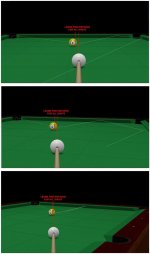Aiming doesn't have to be complicated, especially if you can visualize the object ball contact point and estimate the location of the cue ball contact point. If you can do that then all you have to do is point one at the other.
Accurately visualizing the OBCP and estimating the CBCP takes practice and memorization, and having something to "measure" for each cut angle makes memorizing them much easier. Here's the way I do it:
For each shot I simply notice how far the tip of my cue is pointed away from the OBCP. For thinner cuts this distance is larger (like in the first picture below); for thicker cuts it's smaller (like in the 2nd and 3rd pictures below). I don't do anything special with the information - simply taking notice of how much it is for each shot helps me memorize cuts quickly and repeatably.

This isn't a system in the sense that elaborate methods like x-angle systems are, but "systematically" focusing on exactly where my stick is pointed also helps me get aligned consistently with each shot, which I think is very important.
This is similar to ghost ball, since my stick points to the ghost ball center by definition, but I don't visualize a ghost ball. It's also similar to double-the-distance, but I don't try to find the OB center.
I try to visualize the CB contact point aimed at the OB contact point, and so I think of this as contact point-to-contact point aiming. Noting the distance that my stick is aimed from the OBCP is the visible "marker" that helps my mind remember and recall successful "shot pictures".
Of course, aiming adjustments must be made for squirve caused by sidespin. Noticing the adjusted "offset distance" is also helpful for memorizing cuts with sidespin.
pj <- that'll be $40 please
chgo
Accurately visualizing the OBCP and estimating the CBCP takes practice and memorization, and having something to "measure" for each cut angle makes memorizing them much easier. Here's the way I do it:
For each shot I simply notice how far the tip of my cue is pointed away from the OBCP. For thinner cuts this distance is larger (like in the first picture below); for thicker cuts it's smaller (like in the 2nd and 3rd pictures below). I don't do anything special with the information - simply taking notice of how much it is for each shot helps me memorize cuts quickly and repeatably.

This isn't a system in the sense that elaborate methods like x-angle systems are, but "systematically" focusing on exactly where my stick is pointed also helps me get aligned consistently with each shot, which I think is very important.
This is similar to ghost ball, since my stick points to the ghost ball center by definition, but I don't visualize a ghost ball. It's also similar to double-the-distance, but I don't try to find the OB center.
I try to visualize the CB contact point aimed at the OB contact point, and so I think of this as contact point-to-contact point aiming. Noting the distance that my stick is aimed from the OBCP is the visible "marker" that helps my mind remember and recall successful "shot pictures".
Of course, aiming adjustments must be made for squirve caused by sidespin. Noticing the adjusted "offset distance" is also helpful for memorizing cuts with sidespin.
pj <- that'll be $40 please
chgo
Last edited: